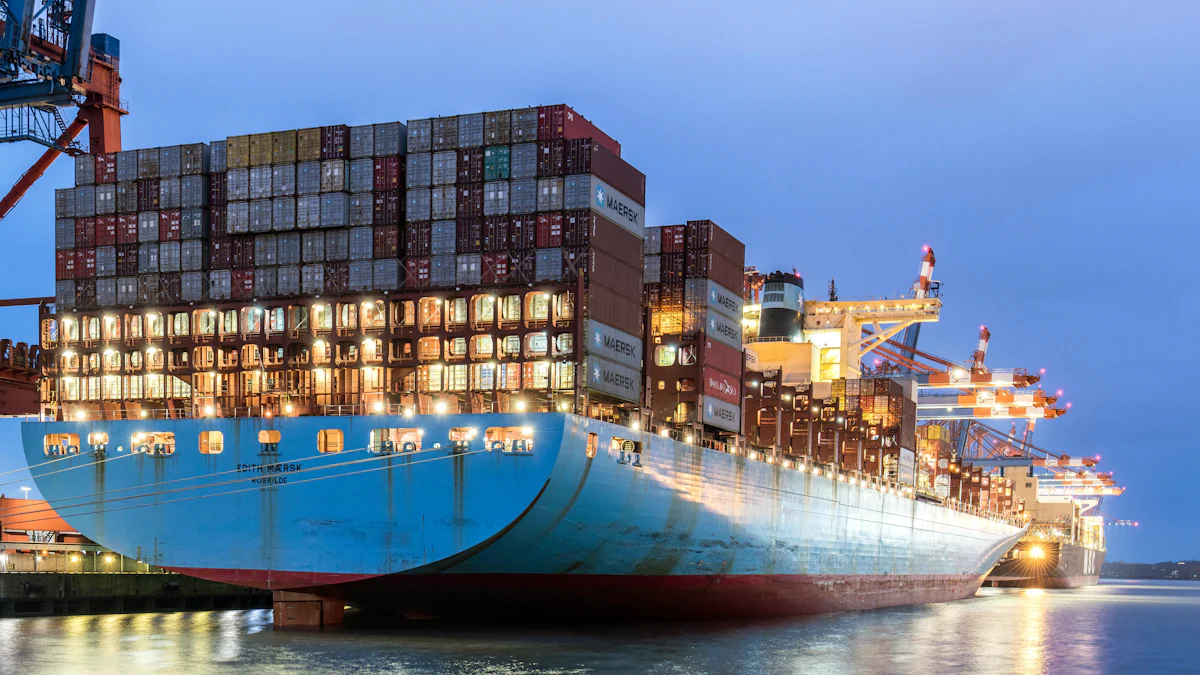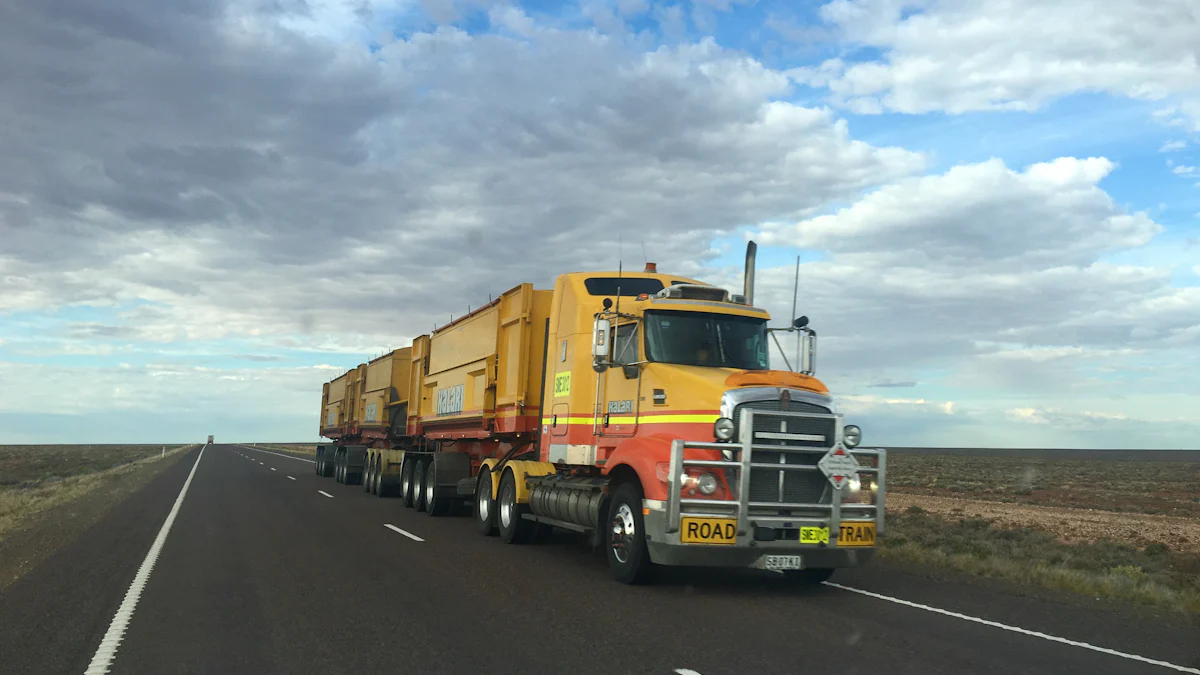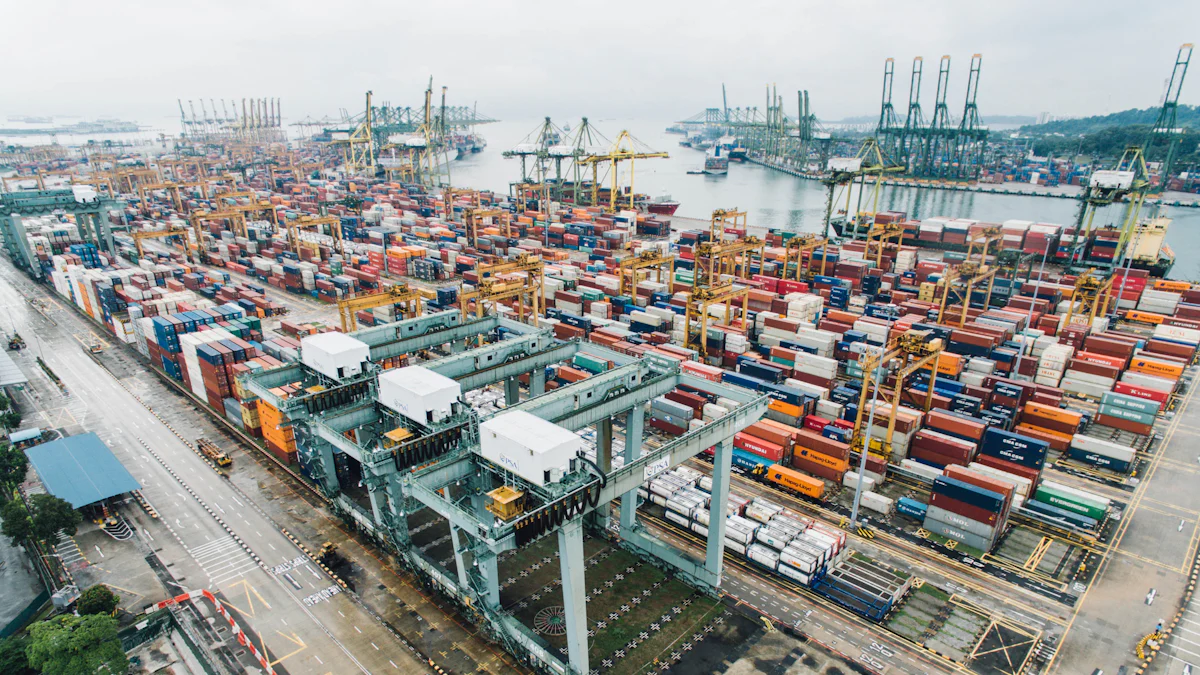How to Choose the Best Freight Service from China to Europe

Choosing the right freight service for load transport from China to Europe can significantly impact your business operations. You must balance cost, reliability, and service offerings to ensure smooth logistics. Challenges like unpredictable delays and fluctuating shipping costs often complicate this decision. For example, in the first half of 2023, the Middle Corridor saw a 77% increase in tonnage, highlighting the growing demand for efficient solutions. JUSDA, a leading freight forwarder in China, offers innovative options like the China-Europe Express Rail, providing faster and cost-effective alternatives for shipping from China.
Types of Freight Services for Load Transport from China to Europe

Air Freight
When to choose air freight
Air freight is ideal when you need to transport small, high-value, or time-sensitive goods. Electronics, fashion items, and perishables often require this method due to their urgency or fragility. If your business prioritizes speed over cost, air freight becomes the most suitable option. For example, transit times for air freight between China and Europe typically range from 5 to 10 days, making it the fastest choice for shipping from China.
Key benefits of air freight
Air freight offers unmatched speed and reliability. It ensures that your goods reach their destination quickly, reducing the risk of delays. This method also provides better security for valuable items, as airports have strict safety protocols. However, it is important to note that air freight comes with higher costs compared to other options.
Suitable for | Delivery Timeline | Cost Efficiency | Example of Goods | |
|---|---|---|---|---|
Air Freight | Small, high-value, or urgent goods | 5-10 days | Higher cost | Electronics, perishables |
Ocean Freight
When to choose ocean freight
Ocean freight is the best choice for large, heavy, or bulk shipments. If your goods are not time-sensitive, this method provides the most economical solution. Machinery, furniture, and textiles are commonly transported via ocean freight. The average transit time ranges from 30 to 40 days, making it suitable for businesses that can plan ahead.
Key benefits of ocean freight
Ocean freight is cost-effective and environmentally friendly. It has a smaller carbon footprint per load compared to air freight. However, it still contributes to environmental issues like ocean acidification. The average cost per container for ocean freight from China to Europe is approximately $1,615 for a 20-foot container and $2,620 for a 40-foot container.
Destination Country | 20’ Container | 40’ Container |
|---|---|---|
United Kingdom | $1,615 | $2,620 |
Germany | $1,615 | $2,620 |
Rail Freight
Overview of the China-Europe Express Rail
The China-Europe Express Rail offers a balanced solution between speed and cost. It connects China and Europe through a reliable railway network, with transit times of 15-20 days. This service is particularly beneficial for moderately urgent goods like automobiles, appliances, and parts. It is three times faster than ocean freight and significantly cheaper than air freight.
Advantages of rail freight for shipping from China
Rail freight provides a cost-effective and timely alternative for load transport from China to Europe. The average rail freight rate is approximately $3,240 per FEU, which is 59% lower than sea freight rates. Additionally, rail freight is more environmentally friendly than air freight, making it a sustainable choice for businesses.
Rail freight transit times: 15-20 days
Ocean freight transit times: 30-40 days
Tip: Rail freight is ideal for businesses looking to balance cost and speed while reducing their environmental impact.
Multimodal Freight
Combining different freight methods
Multimodal freight combines two or more transportation methods to create a seamless shipping experience. This approach is especially useful for load transport from China to Europe, where diverse terrains and distances require flexible solutions. By integrating various modes, you can optimize both cost and efficiency.
Here are the most common combinations used in multimodal freight:
Sea-Rail Combined Transportation: Ideal for moving goods from seaports to inland destinations.
Air-Rail Combined Transportation: Perfect for long-distance travel with rail handling the final leg.
Sea-Air-Rail Combined Transportation: A comprehensive solution for international shipments.
Road-Rail Combined Transportation: Useful for areas not directly accessible by rail.
Air-Road Combined Transportation: Combines air for speed and trucks for last-mile delivery.
Sea-Road Combined Transportation: Efficient for local delivery from ports.
Tip: Choose a combination based on your shipment's urgency, size, and destination. For example, air-road works well for time-sensitive goods, while sea-rail suits bulk shipments.
Benefits of multimodal solutions
Multimodal freight offers several advantages that make it a preferred choice for shipping from China. By using multiple transport modes, you can achieve greater flexibility and cost savings.
Efficiency: Multimodal solutions reduce transit times by selecting the fastest or most suitable mode for each leg of the journey.
Cost Effective: You save money by using economical options like rail or sea for longer distances.
Flexibility: This method adapts to your shipment's specific needs, whether it's speed, cost, or accessibility.
Simplification: Working with one freight forwarder in China simplifies administrative tasks, as they handle all logistics.
Reduced Risk: Fewer handling points lower the chances of damage or loss during transit.
Note: Multimodal freight is an excellent choice for businesses seeking a balance between speed, cost, and reliability. It also supports sustainable practices by optimizing transport modes.
Steps to Evaluate and Compare Freight Providers
Conduct Online Research
Using reviews and testimonials
Start by exploring reviews and testimonials to gauge the reliability of a freight forwarder in China. Look for feedback from businesses that have used their services. Reliable platforms often highlight customer experiences. For instance:
"Our visibility partner of choice! My company has tested multiple container visibility tracking tools and we find Gnosis to be Best in Class." – Devin A., Logistics Inbound Manager
"Seamless Integration and Exceptional Support with Gnosis Freight! Our experience with Gnosis Freight for Container Lifecycle Management has been outstanding." – Miranda W., Supply Chain Supervisor
These insights provide a clearer picture of the provider's strengths and weaknesses, helping you make an informed decision.
Checking provider credentials
Verify the credentials of potential providers to ensure they meet industry standards. Key credentials include:
Licensing: A commercial driver’s license confirms their ability to transport goods safely.
Insurance: Coverage for potential damages protects your shipment.
Experience: Providers with at least five years of experience demonstrate reliability and expertise.
Avoid providers with vague credentials or no cargo insurance, as these can lead to complications during shipping from China.
Request and Compare Quotes
What to include in a quote request
When requesting quotes, include all relevant details to get accurate pricing. Typical components of a freight quote include:
Value-Added Tax (VAT)
Customs Clearance and Documentation Fees
Deferment Schemes and Exemptions
DDP vs. DDU: Deciding Who Pays Duties and Taxes
Providing comprehensive information ensures you receive a detailed and transparent quote.
Comparing quotes beyond price
Don’t focus solely on the price. Review the terms and conditions carefully to identify hidden fees or surcharges. Strong relationships with carriers can also lead to better service and flexible terms.
Technology can enhance the quoting process by automating requests and gathering multiple quotes quickly, enabling better decision-making.
Assess Service Offerings
Evaluating additional services like warehousing
Freight providers often offer value-added services that can streamline your logistics. Common services include:
Palletizing: Reduces spoilage and labor costs.
Order Fulfillment Services: Speeds up deliveries and enhances customer satisfaction.
Return Processing: Improves efficiency by outsourcing returns management.
Pick and Pack: Ensures timely and uniform delivery.
These services can significantly improve your supply chain efficiency.
Checking for tailored solutions
Tailored freight solutions address specific business needs. For instance, companies shipping high-value items benefit from specialized insurance and enhanced security. Flexible providers can also adjust services for seasonal fluctuations, ensuring cost-effectiveness and efficiency. Customized solutions help businesses navigate the complexities of load transport from China to Europe while optimizing delivery times.
Test with a Trial Shipment
Benefits of starting with a small shipment
Testing with a small shipment allows you to evaluate a freight provider without committing to large-scale operations. This approach minimizes risks and helps you identify potential issues early. For instance, you can assess how well the provider handles your goods, ensuring they arrive intact and on time.
A trial shipment also gives you a chance to test the provider's communication and responsiveness. Do they keep you updated throughout the process? Are they proactive in addressing concerns? These insights help you determine if the provider aligns with your business needs.
Tip: Start with a shipment that represents your typical cargo. This ensures the trial reflects real-world conditions and provides accurate results.
Additionally, a small shipment reduces financial exposure. If the provider fails to meet expectations, you avoid significant losses. This cautious approach builds confidence in your decision-making process.
Evaluating performance during the trial
During the trial, focus on key performance indicators (KPIs) to measure the provider's reliability. Track metrics like delivery time, condition of goods, and adherence to agreed terms. Did the shipment arrive within the promised timeframe? Were there any damages or delays?
Communication plays a critical role. Evaluate how well the provider keeps you informed. Clear and timely updates indicate professionalism and reliability.
Note: Pay attention to how the provider handles unexpected challenges. Their problem-solving skills reveal their ability to manage complex logistics.
After the trial, review the overall experience. Compare the provider's performance against your expectations. Use this data to decide whether to proceed with larger shipments. A successful trial builds trust and sets the foundation for a long-term partnership.
Emoji Reminder: ✅ Testing with a trial shipment ensures you make informed decisions while minimizing risks!
Common Mistakes to Avoid When Selecting a Freight Service

Choosing Solely Based on Cost
Why the cheapest option isn't always the best
Selecting a freight service based only on cost can lead to poor outcomes. Low-cost providers often compromise on essential services like timely delivery or proper handling of goods. This can result in delays, damaged cargo, or even financial losses. For example, a provider offering the lowest price might lack adequate insurance coverage, leaving you vulnerable if something goes wrong. Prioritize value over cost by considering factors like reliability, service quality, and customer support.
Hidden costs to watch out for
Freight services often include hidden charges that can inflate the final cost. These fees may not appear in the initial quote but can significantly impact your budget.
Hidden Cost Type | Description |
|---|---|
Port Charges | Fees for loading, unloading, and terminal handling. |
Customs Duties and Taxes | Importation charges, including duties and VAT. |
Terminal Handling Charges (THC) | Costs for managing containers at ports. |
Documentation Fees | Charges for preparing shipping documents. |
Demurrage and Detention Charges | Fees for cargo staying at the port beyond the free storage time. |
Delivery Charges | Costs for transporting goods to the final destination. |
Understanding these hidden costs helps you avoid unpleasant surprises and ensures accurate budgeting.
Ignoring Provider Reputation
Risks of working with unreliable providers
An unreliable freight forwarder in China can disrupt your supply chain. Poor communication may lead to coordination issues, while delays can cause missed deadlines and operational challenges. Financial harm is another risk, as unreliable providers may charge for unnecessary services or fail to deliver on promises. These issues can damage your reputation and result in dissatisfied customers.
How to verify a provider's track record
To ensure reliability, research the provider's history and customer feedback. Look for reviews that highlight their strengths and weaknesses. Verify their credentials, such as licensing and insurance, to confirm their legitimacy. A provider with a proven track record will offer consistent service and minimize risks during shipping from China.
Overlooking Customs and Regulatory Requirements
Consequences of poor customs handling
Neglecting customs clearance can lead to severe consequences. Delays at customs may disrupt delivery schedules, while non-compliance with regulations can result in fines or confiscated goods. These issues can escalate costs and harm your business operations. Proper customs handling ensures smooth load transport from China to Europe.
How JUSDA ensures compliance
JUSDA simplifies customs clearance by leveraging its extensive network and expertise. The company ensures compliance with key requirements, including:
Import duties ranging from 0% to 20%, depending on the goods.
VAT rates between 17% and 27%, based on the destination country.
Accurate documentation and customs processing to avoid delays.
By choosing JUSDA, you gain access to a reliable partner that prioritizes regulatory compliance and smooth operations.
Failing to Plan Ahead
Importance of lead times
Planning your freight shipments ahead of time is crucial for smooth operations. When you schedule shipments early, you gain more control over the logistics process. This approach allows you to secure better rates and avoid rush fees that can inflate costs. Freight providers often reward early bookings with discounts or priority services, which can save you money and reduce stress.
Advance planning also helps you prepare for potential challenges. For example, delays caused by weather, port congestion, or customs inspections can disrupt your supply chain. By building in extra time, you minimize the impact of these issues and ensure your goods reach their destination on schedule.
Tip: Always calculate lead times based on the shipping method you choose. Air freight requires less time than ocean or rail freight, but each has its own timeline to consider.
Risks of last-minute decisions
Relying on last-minute freight arrangements can lead to costly mistakes. When you book late, you limit your options and may have to settle for higher rates or less reliable services. Freight providers often charge premium fees for expedited shipments, which can strain your budget.
Last-minute decisions also increase the risk of delays. For instance, peak shipping seasons like the holiday period or Chinese New Year can overwhelm logistics networks. Without proper planning, your shipment might face extended transit times or even get bumped to a later schedule.
Note: Poor planning can also affect your inventory levels. Late shipments may result in stock shortages, which can harm your reputation and lead to lost sales.
By planning ahead, you avoid these risks and maintain a steady flow of goods. This proactive approach ensures your supply chain remains efficient and cost-effective, even during busy periods.
Emoji Reminder: 🕒 Early planning saves time, money, and stress!
Evaluating freight services carefully ensures your shipments from China to Europe remain cost-effective and reliable. Focus on real-time tracking, flexible incoterms, and tailored solutions to meet your business needs. Avoid common mistakes like improper packaging or skipping freight insurance, as these can lead to delays and losses. Choosing a freight forwarder with expertise in international logistics simplifies the process and ensures compliance with regulations.
JUSDA’s China-Europe Express Rail offers faster delivery times than sea freight and lower costs than air freight. Its comprehensive services, including real-time tracking and customs clearance, make it a dependable choice. By selecting JUSDA, you gain a partner that enhances supply chain efficiency and customer satisfaction.
Tip: Plan ahead and choose rail freight for a balance between speed and cost.
See Also
Discovering Leading Global Logistics Firms: An Essential Guide
Exploring Innovations in Sea Freight Logistics for 2024
Mastering Cost Reduction in Logistics: A Complete Handbook
